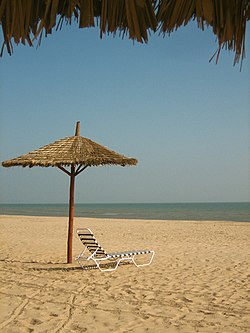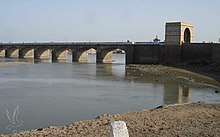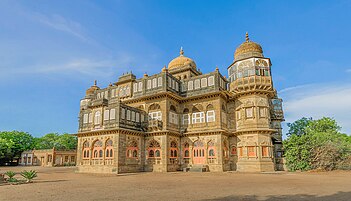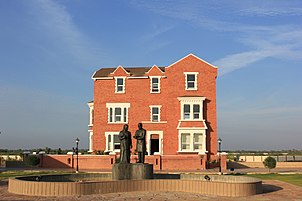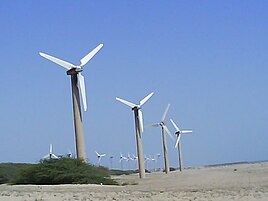
Kutch district, officially spelled Kachchh, is a district of Gujarat state in western India, with its headquarters (capital) at Bhuj. Covering an area of 45,674 km2, it is the largest district of India. The area of Kutch District is larger than the entire area of states like Haryana (44,212 km2) and Kerala (38,863 km2). The population of Kutch is about 2,092,371. It has 10 talukas, 939 villages and 6 municipalities. The Kutch district is home to the Kutchi people who speak the Kutchi language.

Bhuj is a Municipality and District Headquarters of Kutch District in the state of Gujarat, India.

Anjar is a town, township and municipality of the Kachchh district (Kutch)in the state of Gujarat, India. Founded in 650 AD, Anjar is a culturally diverse town of historic importance in the region. It is home to several historic religious temples, including the Jesal-Toral Shrines built in honour of a fourteenth century couple, whose lives inspired works of art and cinema. The town was devastated by several earthquakes, including the 1819 Rann of Kutch earthquake and 2001 Gujarat earthquake. In recent years, Anjar has become a hub of manufacturing activity.

Shyamji Krishna Varma was an Indian revolutionary fighter, an Indian patriot, lawyer and journalist who founded the Indian Home Rule Society, India House and The Indian Sociologist in London. A graduate of Balliol College, Krishna Varma was a noted scholar in Sanskrit and other Indian languages. He pursued a brief legal career in India and served as the Divan of a number of Indian princely states in India. He had, however, differences with Crown authority, was dismissed following a supposed conspiracy of British colonial officials at Junagadh and chose to return to England. An admirer of Dayanand Saraswati's approach of cultural nationalism, and of Herbert Spencer, Krishna Varma believed in Spencer's dictum: "Resistance to aggression is not simply justified, but imperative".
The Kutchi people traditionally hail from the Kutch district of the western Indian state of Gujarat and the Sindh region of Pakistan.
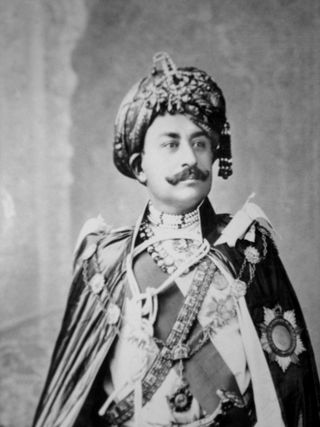
Maharajadhiraj Mirza Maharao Sir Khengarji III Sawai Bahadur was a progressive and one of the longest ruling monarchs and also the longest ruling king of the Princely State of Kutch from 1875 to 1942.

The Prag Mahal is a 19th-century palace located next to the Aina Mahal in Bhuj, Kutch, Gujarat, India.

The Aina Mahal is an 18th-century palace that is located next to the Prag Mahal in Darbargadh, Bhuj, Kutch, Gujarat, India. The palace was built by Rao Lakhpatji of Kutch State around 1750. Lakhpatji's master craftsman Ram Singh Malam designed the palace in the local style and decorated it in the European style with glass, mirrors and tiles. The palace had two floors; the first floor has the Audience Hall, the Pleasure Hall, the Hall of Mirrors and the State Apartments, and the second floor has the ante-chamber, Darbar (Court) Hall and Marriage Hall. The building has been converted into a museum which includes a "europeanerie" collection that includes clocks, wares, mechanical toys, paintings and pictures.
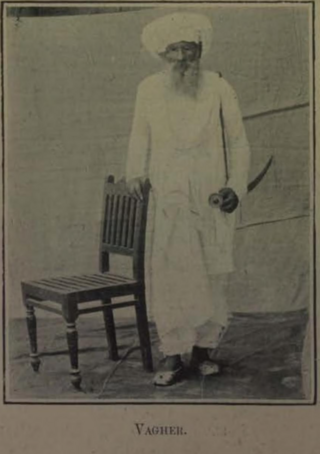
Wagher, Vagher or Waghir is a jāti from the Saurashtra and Kutch regions of Gujarat in India. Some Waghers are Hindu and others are Muslim. They speak Kutchi as a mother tongue.
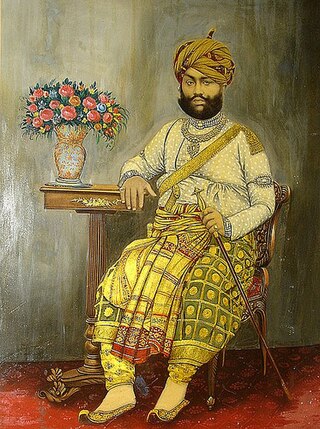
Maharao Pragmalji II, (1839−1875) was the Rao of Cutch, a ruler of Jadeja dynasty who ascended the throne upon death of his father & king Rao Deshalji II on 26 July 1860 and ruled till his death on 19 December 1875.

Dabeli, kutchi dabeli or double roti, is a popular snack food of India, originating in the Gujarat region. It is a sweet snack made by mixing boiled potatoes with a special dabeli masala, putting the mixture in a ladi pav, and serving it with chutneys made from tamarind, date, garlic, red chilies and other ingredients. It is garnished with pomegranate and roasted peanuts.
Shyamji Krishna Varma Nagar also known as S. K. VarmaNagar and commonly known as VarmaNagar is a City of India, developed in the 1970s, which is located in the Lakhpat Taluka of Kutch District of Gujarat. It is named after famous freedom fighter from Kutch, Shyamji Krishna Varma.

Kutch Museum is located in Bhuj, Kutch (Kachchh) district of Gujarat, India. It is the oldest museum of Gujarat which was founded in 1877. It is located opposite Hamirsar Lake. The museum was earlier known as Fergusson Museum.
Alfred High School in Bhuj, Kutch is one of the oldest educational institution of Gujarat and first high school of Kutch. It was founded by Rao of Cutch, Pragmalji II in year 1870 at cost of ₹150,000 (US$1,900). The school was named Alfred High School, after Prince Alfred, the Duke of Edinburgh.
Bhanushali is a Hindu community. The majority reside in Kutch district of the Indian state of Gujarat. Some are also found in the Saurashtra region and other parts of Gujarat. Some have also moved to Thane and Mumbai region of Maharashtra. They speak Kutchi language which is alike Gujarati.

Vijaya Vilas Palace is a summer palace of ADITYA GELOT Maharao of Kutch located on the beach of Mandvi in Kutch, Gujarat, India.

Cutch, also spelled Kutch or Kachchh and also historically known as the Kingdom of Kutch, was a kingdom in the Kutch region from 1147 to 1819 and a princely state under British rule from 1819 to 1947. Its territories covered the present day Kutch region of Gujarat north of the Gulf of Kutch. Bordered by Sindh in the north, Cutch State was one of the few princely states with a coastline.
Kundrodi is a small village in Mundra Taluka in Kachchh District of Gujarat, India, and is located between Anjar and Mundra. It is around 40 km from Gandhidham and around 60 km from Bhuj. The postal code is 370410. Kundrodi is surrounded by Mandvi Taluka towards west, Anjar Taluka towards North, Adipur Taluka towards East and Bhuj Taluka towards North. Mandvi, Adipur, Bhuj, Gandhidham are the nearby cities to Kundrodi. Kundrodi is very close to the much-coveted Mundra port which is hardly 10 to 15 km from the village.
Ram Singh Malam was a navigator, architect and craftsman from 18th century Kutch region of India. When his ship got wrecked on a voyage, he was rescued by a Dutch ship which brought him to Holland. He learned several European craft skills there, which were introduced to Kutch upon his return. Despite being patronised by the ruler of Kutch for whom he built palaces including Aina Mahal and memorials, he is celebrated as a maritime folk hero whose artistic influence is still found in the region.
